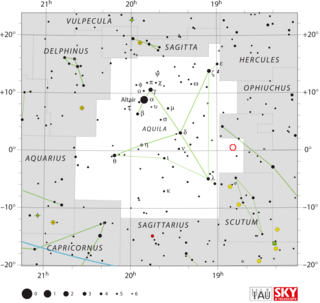
V603 Aquilae was a bright nova first observed in the constellation Aquila in 1918. It was the brightest "new star" to appear in the sky since Kepler's Supernova in 1604. Like all novae, it is a binary system, comprising a white dwarf and donor low-mass star in close orbit to the point of being only semidetached. The white dwarf sucks matter off its companion, which has filled its Roche lobe, onto its accretion disk and surface until the excess material is blown off in a thermonuclear event. This material then forms an expanding shell, which eventually thins out and disappears.
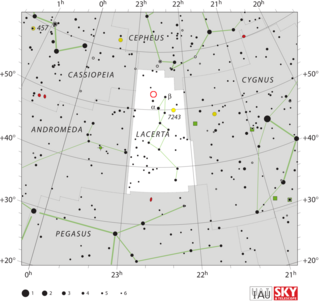
DI Lacertae or Nova Lacertae 1910 was a nova in constellation Lacerta which appeared in 1910. It was discovered by Thomas Henry Espinell Compton Espin at Wolsingham Observatory on 30 Dec 1910, at which time it was an 8th magnitude object. Subsequent examination of pre-discovery photographic plates showed that the outburst occurred sometime between 17 November 1910 and 23 November 1910. It reached a peak brightness of magnitude 4.6 on 26 November 1910, making it visible to the naked eye. Before the nova event DI Lacertae was a 14th magnitude star, and by 1950 it had returned to 14th magnitude.
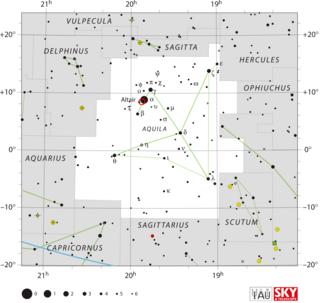
V500 Aquilae also known as Nova Aquilae 1943 was a nova which appeared in the constellation Aquila, very near the star Altair, in 1943. It was discovered by Cuno Hoffmeister on photographic plates taken at Sonneberg Observatory on 5 September 1943, when it had a photographic magnitude of 12. It reached its peak brightness sometime between 13 April 1943 when it was fainter than photographic magnitude 13.5, and 2 May 1943 when its photographic magnitude was 6.55.

V373 Scuti was a nova which appeared in 1975 in the southern constellation of Scutum. It was announced on June 15, 1975 by Paul Wild at the Zimmerwald Observatory, Switzerland. At the time the magnitude was about 7.9. The peak magnitude of 7.1 occurred a month earlier on May 11.

V1668 Cygni was a nova that appeared in the northern constellation of Cygnus, situated a couple of degrees to the southeast of the star Rho Cygni. It was discovered by Canadian variable star observer Warren Morrison on September 10, 1978, and reached a peak brightness of around 6.22 apparent magnitude on September 12. The luminosity of the source at this time was about 100,000 times the brightness of the Sun, and likely remained at that level for several months. The expansion velocity of the nova shell was deduced through spectroscopy to be 1,300 km/s.
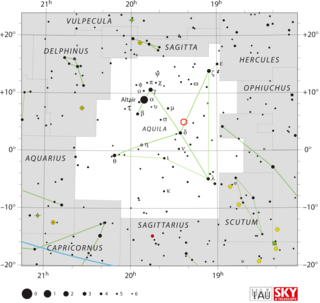
V1494 Aquilae or Nova Aquilae 1999 b was a nova which occurred during 1999 in the constellation Aquila and reached a brightness of magnitude 3.9 on 2 December 1999. making it easily visible to the naked eye. The nova was discovered with 14×100 binoculars by Alfredo Pereira of Cabo da Roca, Portugal at 18:50 UT on 1 December 1999, when it had a visual magnitude of 6.0.
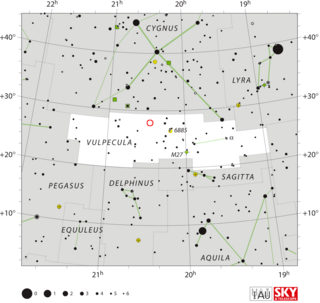
QU Vulpeculae, also known as Nova Vulpeculae 1984 Number 2, was the second nova which occurred in 1984 in the constellation Vulpecula. It was discovered by Peter Collins, an amateur astronomer from Cardiff, California at 22:08 UT on 22 December 1984. At the time of its discovery, the nova's apparent magnitude was 6.8. By the next night, Collins reported its brightness had increased to magnitude 5.6, making it visible to the naked eye.

V606 Aquilae was a nova, which lit up in the constellation Aquila in 1899. The brightest reported magnitude for this nova was apparent magnitude 5.5, making it a naked eye object. It was discovered by Williamina Fleming on a photographic plate taken on 21 April 1899 at the Harvard College Observatory. On the discovery plate, its photographic magnitude was later determined to be 6.75. It was not seen on the plate taken on 1 November 1898, and there were no reported observations of the region around the star during the 171 day interval before Fleming's discovery, so it is possible that the actual maximum of the event was missed. By 27 October 1899 it had faded to 10th magnitude, and on 9 July 1900 Oliver Wendell reported its brightness to be between magnitude 11.5 and 12.0.

DM Lyrae is a dwarf nova in the constellation Lyra. This binary system is composed of a primary star of unknown type, and a white dwarf companion. It erupted in 1928 and 1996 and reached about magnitude 13.
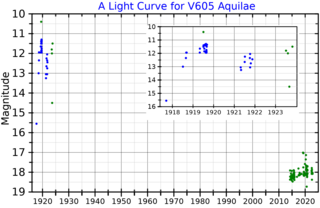
V605 Aquilae, in the constellation Aquila, is the variable central star of the planetary nebula Abell 58. It is a highly unusual hydrogen-deficient carbon-rich star.

RW Ursae Minoris is a cataclysmic variable star system that flared up as a nova in the constellation Ursa Minor in 1956.

XX Tauri was a nova, which appeared in the constellation Taurus in 1927. It was discovered by Arnold Schwassmann and Arno Arthur Wachmann at Hamburg Observatory on an objective prism photographic plate taken on 18 November 1927. Subsequent examination of pre-discovery photographic plates taken at the Harvard College Observatory showed that the peak brightness, magnitude 5.9, occurred on 1 October 1927, at which point it may have been faintly visible to the naked eye. By 1988 it had faded below magnitude 19.8.

CK Vulpeculae is an object whose exact nature is unknown. It was once considered to be the oldest reliably-documented nova. It consists of a compact central object surrounded by a bipolar nebula.
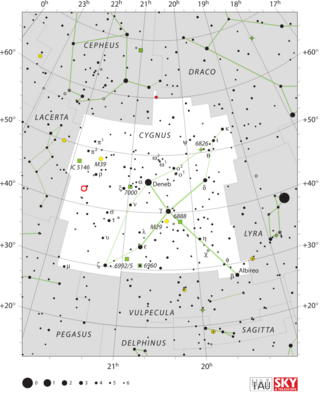
Q Cygni, is a star located in the constellation Cygnus. It is also known as Nova Cygni 1876, and has the designation NGC 7114, and HR 8296. Nova Cygni is located in the northwestern portion of Cygnus along the border with Lacerta.

V368 Aquilae, also known as Nova Aquilae 1936 no. 2 was the second nova which occurred in the constellation of Aquila during 1936. It was discovered on a photographic plate by Nils Tamm at Kvistaberg Observatory on 7 October 1936. At the time of discovery it was at photographic magnitude 7, and was already fading. Pre-discovery photographs showed that peak brightness occurred around 25 September 1936, at which time it had reached apparent magnitude 5.0, making it visible to the naked eye. The nova was described as being fiery red due to strong Hα emission, and for a time could be seen with binoculars simultaneously with V356 Aquilae, another nova which Nill Tamm had discovered a month earlier.

QZ Aurigae, also known as Nova Aurigae 1964, was a nova which occurred in the constellation Auriga during 1964. It was discovered by Nicholas Sanduleak on an objective prism photographic plate taken at the Warner and Swasey Observatory on 4 November 1964. Examination of pre-discovery plates from Sonneberg Observatory showed that the eruption occurred in early February 1964, and it had a photographic magnitude of 6.0 on 14 February 1964. Its brightness declined in images taken after the 14th, suggesting that its peak brightness was above 6.0. It was probably visible to the naked eye for a short time.
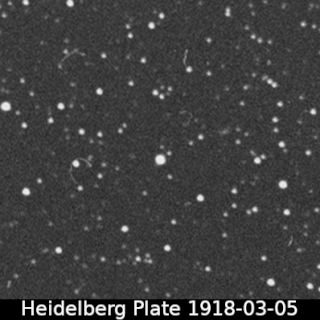
GI Monocerotis, also known as Nova Monocerotis 1918, was a nova that erupted in the constellation Monoceros during 1918. It was discovered by Max Wolf on a photographic plate taken at the Heidelberg Observatory on 4 February 1918. At the time of its discovery, it had a photographic magnitude of 8.5, and had already passed its peak brightness. A search of plates taken at the Harvard College Observatory showed that it had a photographic magnitude of 5.4 on 1 January 1918, so it would have been visible to the naked eye around that time. By March 1918 it had dropped to ninth or tenth magnitude. By November 1920 it was a little fainter than 15th magnitude.

V1370 Aquilae, also known as Nova Aquilae 1982, is a nova that appeared in the constellation Aquila during 1982. It was discovered by Minoru Honda of Kurashiki, Japan at 20:30 UT on 27 January 1982. At that time the Sun had moved just far enough from Aquila to allow the nova to be seen in the morning sky. Although it was discovered photographically, its apparent magnitude was 6–7, making it potentially visible to the naked eye under ideal conditions. A possible magnitude 20 progenitor was located on the Palomar Sky Survey prints. Spectra of the object were taken in February 1982 at Asiago Astrophysical Observatory, which confirmed that it is a nova.
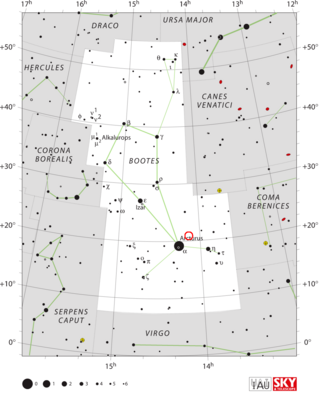
AB Boötis, also known as Nova Boötis 1877 and occasionally Nova Comae Berenices 1877, is an object that may have undergone a nova outburst in 1877. It was discovered by Friedrich Schwab at Technische Universität Ilmenau in 1877. He reported observing the star as a 5th magnitude object, visible to the naked eye, on 14 nights during the period from 30 May 1877 through 14 July 1877. The star was lost, and despite several searches in subsequent years, no other 19th century observations of the nova were reported. Downes et al. estimate that Schwab's reported coordinates for the star may have had a precision no better than 1/2 degree. In 1971, A. Sh. Khatisov suggested that the star Schwab saw was BD +21°2606, but that identification may be incorrect.

Nova Puppis 1673, also known as NSV 3846, is a probable nova in the constellation Puppis. It was discovered by Jean Richer on January 12, 1673 during the last year of an expedition Richer made to Cayenne, French Guiana. Richer measured its position on the sky using a mural quadrant, resulting in the most precise position available for a seventeenth-century nova that might be rediscovered by modern observers. At the time of its discovery the nova had a visual magnitude of 3, making it easily visible to the naked eye.





















